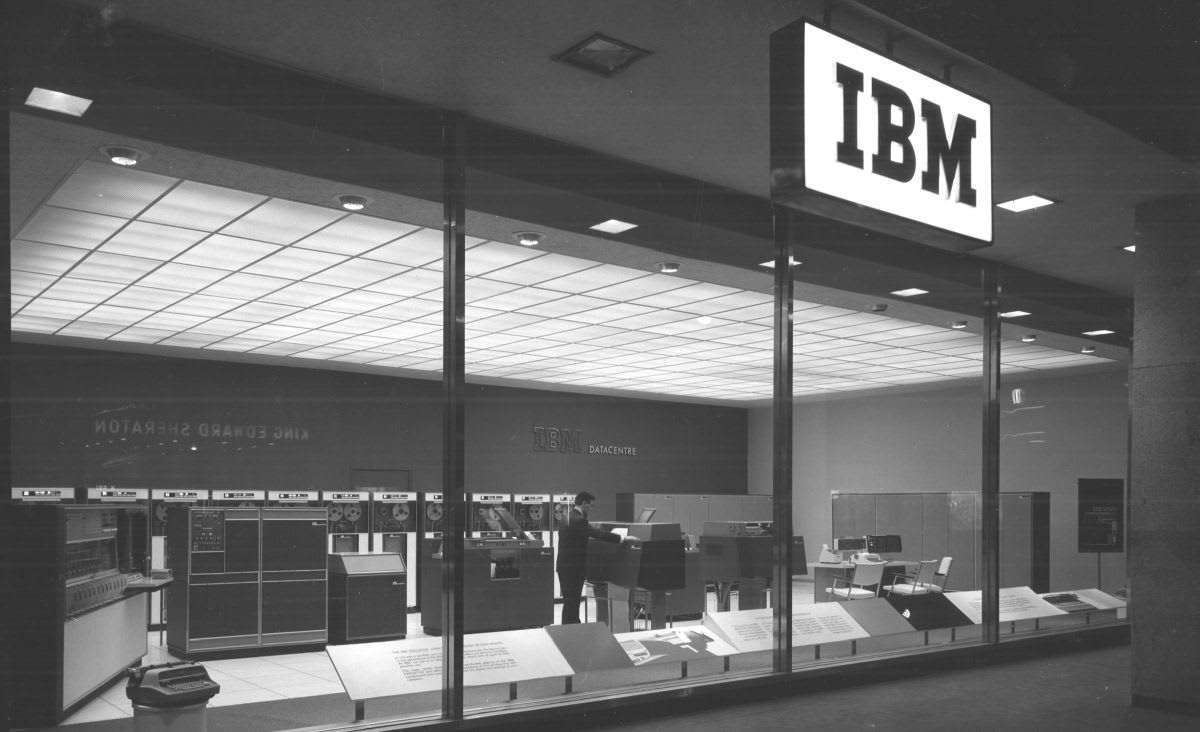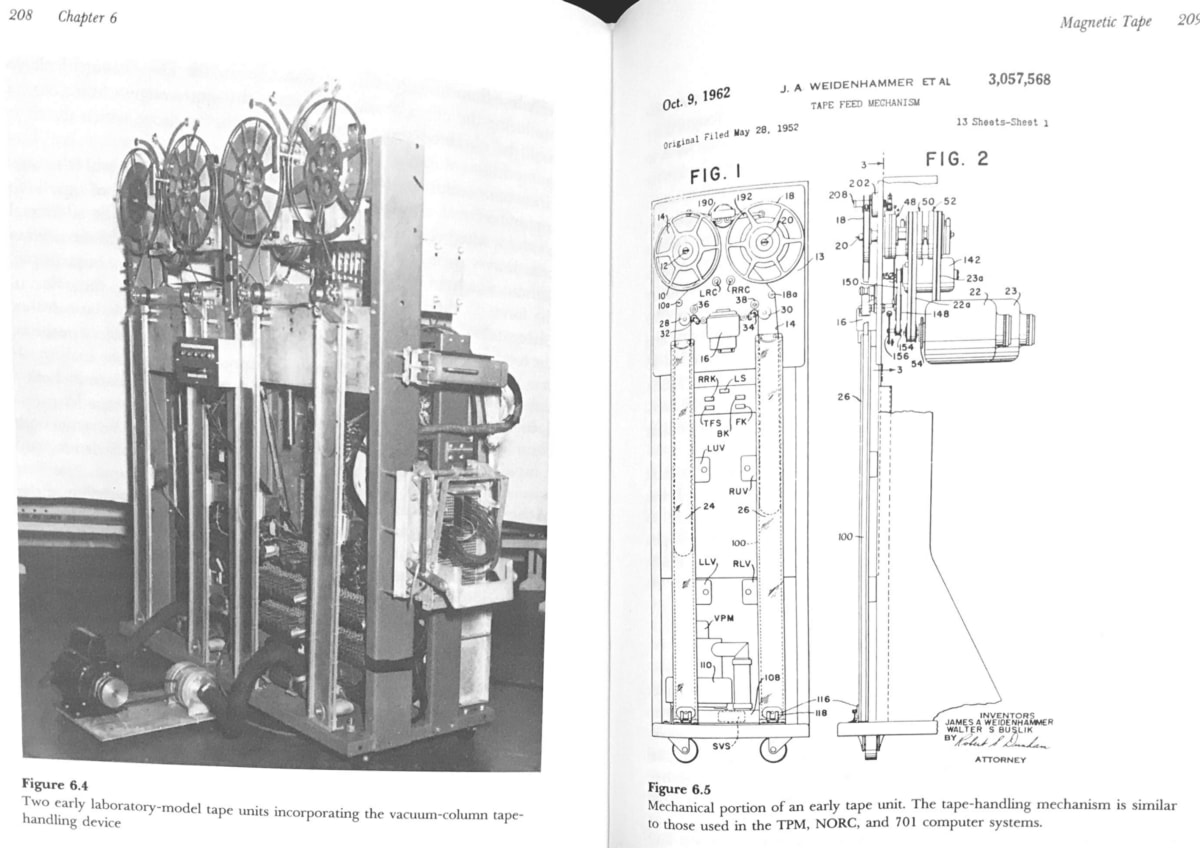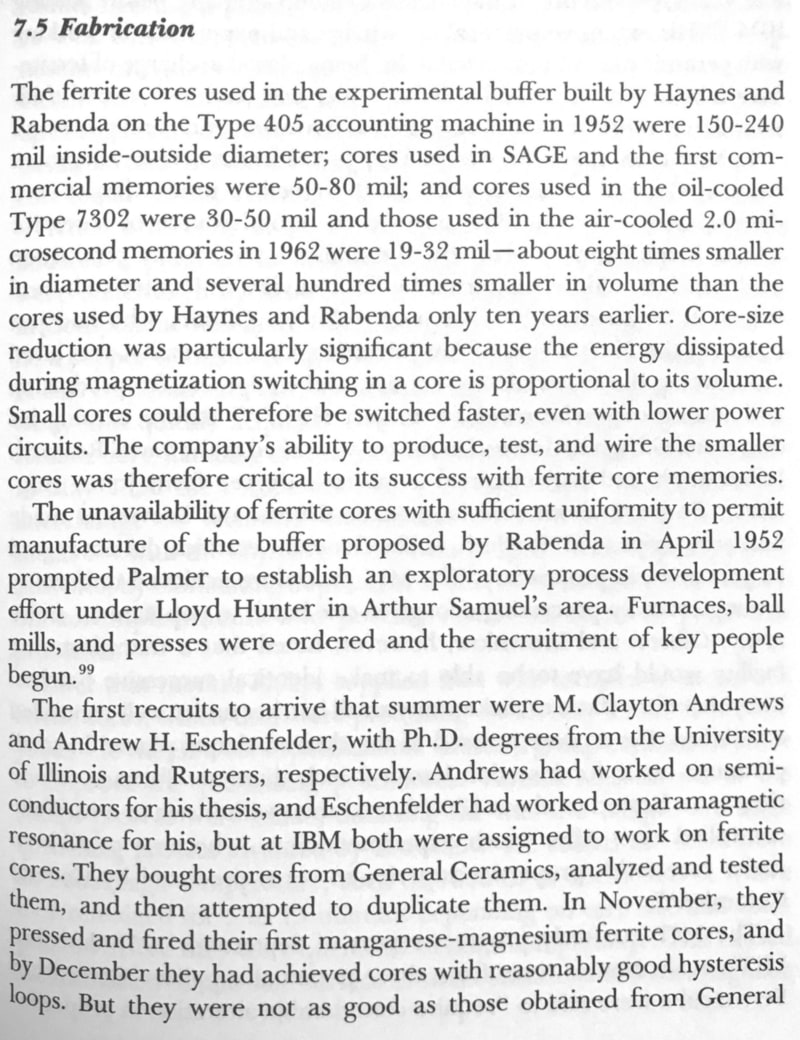
Sans surprise ce livre est édité par le MIT Press ce qui est souvent un gage de qualité. Ses auteurs, Charles J. Bashe, Lyle R. Johnson, John H. Palmer sont tous des “senior member of the staff at IBM’s Thomas J. Watson Research Center” : ils savent de quoi ils parlent. Bashe a coécrit des articles avec le célèbre Gene Amdhal…
On ne peut nier l’influence d’IBM sur l’histoire de l’informatique moderne, que cela soit dans le domaine matériel comme logiciel. De nombreux systèmes encore utilisés 50 ans plus tard sont des inventions issus des laboratoires ou des usines d’IBM. Deux exemples : les disques durs et les machines virtuelles.
Ce livre est épais, plus de 700 pages. Comme il contient beaucoup de détails techniques (schémas électroniques ou mécanique par exemple), je m’en sers plus comme référence, c’est à dire que je vais piocher dedans le sujet ou la période qui m’intéresse.
Il contient aussi des photos d’époque.

Le style est fluide et plaisant, sans fioriture : ce livre est facile à lire, et c’est à souligner, n’abuse pas des acronymes, en tout cas pas en dehors de leur contexte.
Il est composé de 14 chapitres :
1 Punched Cards and Plugwires 1
The Hollerith era. IBM punched — card machine development Steps toward fully automatic digital calculation.
2 Electronic Calculation 34
Flip — jlops and counters. The electronic multiplier. The SSEC, a super
calculator. The Type 604, an electronic workhorse. The Card — Programmed Electronic Calculator.
3 A Machine for Ordinary Businesses 73
The choice of drum storage. The drum — augmented 604. The influence of
mathematical computation. The Magnetic Drum Calculator. The squeeze or ressources. The president’s decision.
4 The Tape Processing Machine 102
The CRT memory project. The Data Processing Test Assembly. Plans for the
Tape Processing Machine. TPM engineering. A time for waiting.
5 First-Generation IBM Computers 130
The need for fast computers. Planning for the Defense Calculator
Engineering considerations. The Type 701 computer. The Type 650
Magnetic Drum Calculator. The Type 702 Electronic Data Processing
Machine. Later vacuum tube computers.
6 Magnetic Tape 187
Magnetic tape studies in IBM. Magnetic recording in Poughkeepsie. Tape handling devices. The need for better tape. First-generation tape machines.
More and faster. Excursions from the beaten path.
7 Ferrite-Gare Memories 231
Getting started in ocres. Project SAGE. Commercial memories. Pushing the
limits. Fabrication. Patents and innovation.
8 Disk Storage 273
A separate group. The source recording project. Dish — array feasibility and
early development. Record addressing and RAMAC. Slider development in
San Jose. IBM’s first slider product. Collateral storage development. The
removable disk pack.
9 Programming 315
The subroutine library. Two IBM assembly programs. The Speedcoding
language and interpreter. The FORTRAN language and compiler.
Programming as a marketing aid. SHARE, a user organization. IBM’s organization for programming. Early experience with operating systems. A
proliferation of machine types and programs. A conference on programming.
10 Transistors 372
The frst transistors at IBM. Entering the solid — state era. Point — contact to
junction transistors. Drift transistors. Current — switch circuits. Development and manufacturing. Standard Modular System.
11 Project Stretch 416
“We must take a giant step.” Project Stretch formulation. System planning. Logical design and engineering. The Type 7090, first Stretch — technology
product. The 7030 program. Stretch delivery and assessment. Epilogue.
12 Broadening the Base 459
Electronics and accounting machines. The Type 1401 data processing
system. Other 1400 series computers; the Report Program Generator. High —
speed printers; the chain and train. Document reading machines. Small
scientific computers; process control. Teleprocessing and the SABRE system.
13 Research 523
The Watson Laboratory. Research in Poughheepsie. Separating research from development. Basic research in Zurich. Restructuring the San Jose
laboratory. Preparing for the new research center. Exciting projects. Growing problems.
14 The Architectural Challenge 571
Adjusting ta new technology. The changing environment. Coping with
growth. Product diversity. Architectural considerations. Commitment to change.
Appendices :
A Sequence Control in the SSEC 585
B TPM Organisation and Operation 589
C Havens Delay Unit Circuit Operation 599
D 701 System Design Summary 603
References and Notes 607
Index 695
About the Authors 717.
La démarche des auteurs est de suivre le fil des projets IBM et des réalisations techniques réalisées dans ce cadre, en mentionnant non seulement celles qui ont abouties mais aussi celles qui ont été abandonnées, quelque soit la cause, politique, technique, marketing, concurrentielle, etc.
Chaque technologie est méticuleusement décrite, par exemple le chapitre 12.4 sur les imprimantes à haute vitesse comprend 12 pages (de 150 lignes par minute vers 1933 jusqu’à plus de 1000 en 1963).
Il existe sans doute une littérature sur IBM plus axée sur l’entreprise, ses hommes et sa politique. Mais du point de vue des technologie ce livre est une mine d’or : je recommande vivement sa lecture à toute personne intéressée par l’histoire des technologies employées dans l’informatique de 1930 à 1960.
L’important chapitre Notes redirigera le lecteur-chercheur vers les articles d’époque.
Résumé
In describing the technical experiences of one company from the beginning of the computer era, this book unfolds the challenges that IBM’s research and development laboratories faced, the technological paths they chose, and how these choices affected the company and the computer industry. It chronicles the transformation of IBM into a computer company in a remarkably few years, discussing projects that ended in frustration as well as the more successful ones, and providing a sense of the atmosphere, the people, and the decision-making processes involved during the company’s rapid technological transformation. IBM’s Early Computers is a unique contribution to the modern history of computers. It focuses on engineering alternatives rather than business and general management considerations and reveals the significance of imaginative solutions to problems in design and technology, from initial experiments with electronics in digital machines to the threshold of the System 360 era. This fair and balanced account of IBM’s role in shaping today’s electronic revolution identifies the individuals (both inside and outside the company) whose pioneering work influenced developments at IBM. The book’s fourteen chapters briefly survey the card machine era and then cover electronic calculation, the magnetic drum calculator, the Defense Calculator and other first-generation products, ferrite core memories, magnetic tape, and disk storage development, programming, transistors, ‘’Project Stretch’’ (which involved disappointments but led to one of IBM’s greatest successes) high-speed printers, research, and new-product-line considerations. Charles J. Bashe, Lyle R. Johnson, John H. Palmer, and Emerson W Pugh are senior members of the staff at IBM’s Thomas J. Watson Research Center, each with many years of technical and managerial experience in the developments they describe. IBM’s Early Computers is included in the History of Computing Series, edited by I. Bernard Cohen and William Aspray
Title: IBM's Early Computers
Series: History of Computing
Hardcover: 744 pages
Publisher: The MIT Press; First Edition edition (December 3, 1985)
Language: English
ISBN-10: 0262022257
ISBN-13: 978–0262022255







